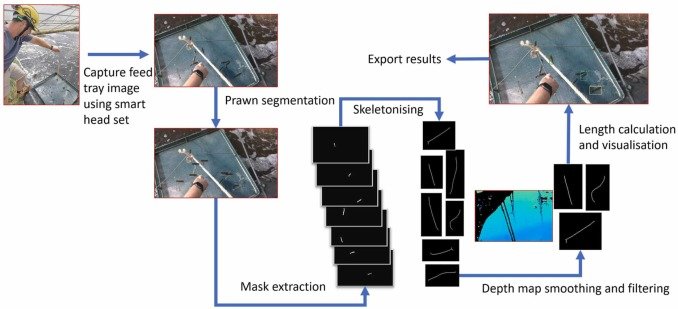
The aquaculture industry constantly grapples with the challenge of optimizing feeding and harvesting strategies to ensure healthy growth and maximize financial gains. However, understanding the growth and distribution of shrimp is essential for making informed decisions.
Insufficient understanding of shrimp growth can lead to financial losses, such as premature crop harvesting. Researchers at CSIRO have developed innovative technology that is revolutionizing the way we gather information about shrimp growth. They have created a device that allows shrimp farmers to collect data on shrimp while they are in feeding trays.
The challenge of understanding shrimp growth
For shrimp producers, and aquaculture of any species, comprehending the growth and distribution of their populations is paramount. Inaccurate information can result in suboptimal feeding and harvesting practices. For instance, harvesting shrimp before they reach their optimal size can lead to significant profit losses. To avoid these costly errors, detailed knowledge of shrimp growth is crucial.
The importance of sampling
The key to maintaining a good understanding of shrimp growth is frequent sampling. However, the most commonly used practice involves capturing, weighing, and counting the shrimp to estimate average weight, with a sample of individuals used to determine average size.
This method is costly and labor-intensive and does not allow for higher-frequency sampling, in addition to stressing the animals. As a result, shrimp growth data can be scarce and unrepresentative.
An innovative solution
In pursuit of a more effective solution, researchers have developed a novel and exciting approach. Instead of collecting data through traditional techniques, they have proposed using cutting-edge technology.
Specifically, researchers have designed smart glasses equipped with a depth camera, computer vision, and machine learning to detect the distribution and growth of shrimp in feeding trays.
The role of smart glasses
Smart glasses are a central component of this innovative strategy. These glasses enable shrimp farmers to collect shrimp growth data while conducting daily checks of the feeding trays. The researchers equipped a “smart headset” with cameras that can automatically capture images of the feeding trays without disrupting daily operations on shrimp farms.
This solution offers the advantage of high-frequency data collection, as feeding trays are inspected daily. Thus, an accurate and up-to-date picture of shrimp growth is obtained. According to the study, shrimp producers can use “smart glasses,” such as Google Glass, to interact with the camera and display the results.
Cutting-Edge technology: computer vision and machine learning
The key to the success of this innovative approach lies in the use of computer vision and machine learning. Researchers have developed a system that processes the images captured by the “smart glasses” and employs machine learning algorithms to detect and track shrimp growth in the feeding trays. This enables shrimp farmers to obtain real-time information about the growth of their populations.
Promising results
This new approach has already demonstrated its value. It has been successfully implemented in four shrimp ponds during a growing season. The results have been promising, as it efficiently and accurately detected growth trends in aquatic animals.
Conclusion
The study introduces an approach for automatically measuring shrimp size during feeding tray inspections using a “smart headset,” Google Glass, computer vision, and machine learning.
“Smart glasses in combination with Google Glass do not add any extra work for aquaculturists but are capable of capturing images. Then, the computer vision method based on deep learning detects the shrimp, and the depth camera allows for length estimation,” the researchers conclude.
They also report that “The distribution of shrimp length and growth trends during the growing season, as calculated by our approach, closely match field measurements.”
This innovation promises not only to maximize benefits for producers but also to ensure a more sustainable approach to shrimp production.
The study was funded by CSIRO’s Digiscape Future Science Platform.
Contact
Mingze Xi
Data61, CSIRO
Black Mountain, ACT
Australia
Email: mingze.xi@csiro.au
Reference (open access)
Mingze Xi, Ashfaqur Rahman, Chuong Nguyen, Stuart Arnold, John McCulloch- 2023. Smart headset, computer vision and machine learning for efficient prawn farm management, Aquacultural Engineering, Volume 102, 2023, 102339, ISSN 0144-8609, https://doi.org/10.1016/j.aquaeng.2023.102339.

